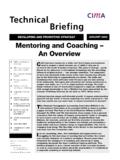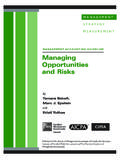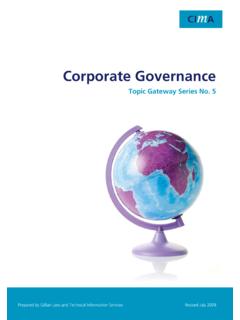Transcription of Key Approaches and Trends in Strategy - CIMA
1 Topic Gateway Series Key Approaches and Trends in Strategy Key Approaches and Trends in Strategy Topic Gateway Series No. 42. 1. Prepared by Louise Ross and Technical Information Service December 2007. Topic Gateway Series Key Approaches and Trends in Strategy About Topic Gateways Topic Gateways are intended as a refresher or introduction to topics of interest to CIMA members. They include a basic definition, a brief overview and a fuller explanation of practical application. Finally they signpost some further resources for detailed understanding and research. Topic Gateways are available electronically to CIMA members only in the CPD. Centre on the CIMA website, along with a number of electronic resources. About the Technical Information Service CIMA supports its members and students with its Technical Information Service (TIS) for their work and CPD needs.
2 Our information specialists and accounting specialists work closely together to identify or create authoritative resources to help members resolve their work related information needs. Additionally, our accounting specialists can help CIMA. members and students with the interpretation of guidance on financial reporting, financial management and performance management, as defined in the CIMA. Official Terminology 2005 edition. CIMA members and students should sign into My CIMA to access these services and resources. The Chartered Institute of Management Accountants 26 Chapter Street London SW1P 4NP. United Kingdom T. +44 (0)20 8849 2259. F. +44 (0)20 8849 2468. E. 2. Topic Gateway Series Key Approaches and Trends in Strategy Key Approaches and Trends in Strategy Definition Strategy is how organisations create and sustain superior performance.
3 It is defined as: 'A course of action, including the specification of resources required, to achieve a specific objective.'. CIMA Official Terminology, 2005. Corporate Strategy is expressed in a strategic plan, the top level of a cascade of plans for the various functions and divisions, and is defined as: A statement of long-term goals along with a definition of the strategies and policies which will ensure achievement of these goals.'. CIMA Official Terminology, 2005. The relationship of divisional or functional Strategy to policy making and lower-level (operational) planning is illustrated below. Manufacturing example Service example Policies Produce technically superior Offer low-cost services and products cultivate brand awareness Strategy Spend >15% of gross revenue Local price setting to on research and development undercut competition Tactics Recruit engineers from the best Price deals to boost university technology courses volume Operational Monitor customer feedback on Systematic use of brand planning product performance awareness feedback Adapted from Fig CIMA Official Terminology (2005).
4 The implementation of Strategy requires the collection and monitoring of both internal and external data. This is known as strategic management accounting, defined as: The form of management accounting in which emphasis is placed on information which relates to factors external to the entity, as well as non-financial information and internally generated information.'. CIMA Official Terminology, 2005. 3. Topic Gateway Series Key Approaches and Trends in Strategy Context In the current syllabus, CIMA students will learn and may be examined on this topic in the following papers: Managerial level: P4 Organisational Management and Information Systems and P5 Integrated Management Strategic level: all papers TOPCIMA. Related concepts The other (lower level) types of planning are discussed in the Planning and Forecasting topic gateway.
5 Available from: [Accessed 12 March 2008]. Two specific tools which assist with the planning and implementation of Strategy are also the subject of specific topic gateways, namely the Balanced Scorecard and the CIMA Strategic Scorecard . Available from: [Accessed 12 March 2008]. Overview and brief history There is a huge body of work on corporate Strategy , and useful insights from both the academic or practitioner perspective. The overlap between the two seems considerable academics practise as consultants and robust 'field work' is published by consulting firms, sometimes in quality business magazines. This topic gateway has to be selective, but will include links to other resources so that readers interested in, for example, influential theorists can identify those other than the few listed here. It is important also to point out that there are both advocates and critics of strategic planning.
6 Broadly, there are two aspects to Strategy : planning (or Strategy formulation). implementation. 4. Topic Gateway Series Key Approaches and Trends in Strategy Strategy is about giving direction, rather than specific commands. The hallmark of an effective strategist is that he or she considers all the relevant factors in proportion to their significance. However, he or she is able to make decisions quickly as a result of this analysis, rather than panic or caprice. Strategy should also be developed in the context of the ultimate purpose of the entity. This might be to build shareholder value (in the case of companies) or to serve the public good (in not-for-profit entities). However, critics question whether making strategic plans is as useful to large organisations as seizing opportunities or coping with disasters as they arise.
7 Henry Mintzberg, one of the most influential writers on strategic planning, argues that planning can corrode commitment and prevent change. In his book 'The Rise and Fall of Strategic Planning', he concludes that planning and Strategy are mutually exclusive activities, and considers the term strategic planning to be an oxymoron. To an extent, these apparently opposing views can be reconciled. Advocates of strategic planning explain they are not creating inflexible plans which cannot respond to unexpected events. They argue that strategic planning contains the guiding principles which provide direction so that the organisation can respond to such events. These different positions on corporate Strategy are reflected in its history. After the Second World War, many concepts about Strategy were translated from the military into the corporate world.
8 In the 1960s, Strategy meant complex and detailed planning based on economic models and detailed forecasts. The credibility of this approach was undermined in the following decades as a result of the impact of significant oil price rises (meaning the assumptions underlying the plans had to be revised). There was also the success of many Japanese companies, for whom detailed planning was apparently less of a priority. One of Mintzberg's earlier contributions to the field was to categorise different Approaches to Strategy -making. In 1973, he suggested these were: the adaptive the entrepreneurial planning. 5. Topic Gateway Series Key Approaches and Trends in Strategy Other Approaches or 'schools' were added subsequently by Mintzberg, Ahlstrand and Lampel. They are explained and critiqued here for those who wish to explore the theory further.
9 [Accessed 12 March 2008]. Another influential theorist was Michael Porter, who invigorated the field in 1980. by arguing that corporate Strategy should be based on the conditions of the industry, and the company's relative position in that industry. Organisations should identify their strengths (or 'core competencies') and concentrate on or discover markets where those skills could be exploited. The concept of core competencies was relevant for both organic and acquisitive growth, informed diversification and divestment strategies. Porter's focus was on the interface between the organisation and its environment. Competencies Theory was developed into a more 'inside out' focus when Gary Hampel and C. K. Prahalad published their core competencies model in 1990. They took as the starting point for Strategy development the core strengths of the organisation, and advised that a core competence was recognised by: providing potential access to a wide variety of markets making a significant contribution to the benefits of a product as perceived by customers being hard to replicate by competitors.
10 Management's role was to create the environment to facilitate the creation of these core competencies. The competencies themselves were intended to equip entities to adapt quickly to changing environments and to produce innovative, even unexpected, products. Around the same time, Jack Welch (whose perspectives still influence many business leaders) disbanded his company's planning department of about 200. staff at General Electric in the USA. He argued that the planners were divorced from the front-line, and were too concerned with planning in detail and not enough on competitive positioning and identification of potential markets. Welch devolved responsibility for strategic planning to the heads of GEC's 12 business units, expecting them to be more responsive to change. 6. Topic Gateway Series Key Approaches and Trends in Strategy This emphasis on strategies to equip organisations to manage change has only increased in recent years.











